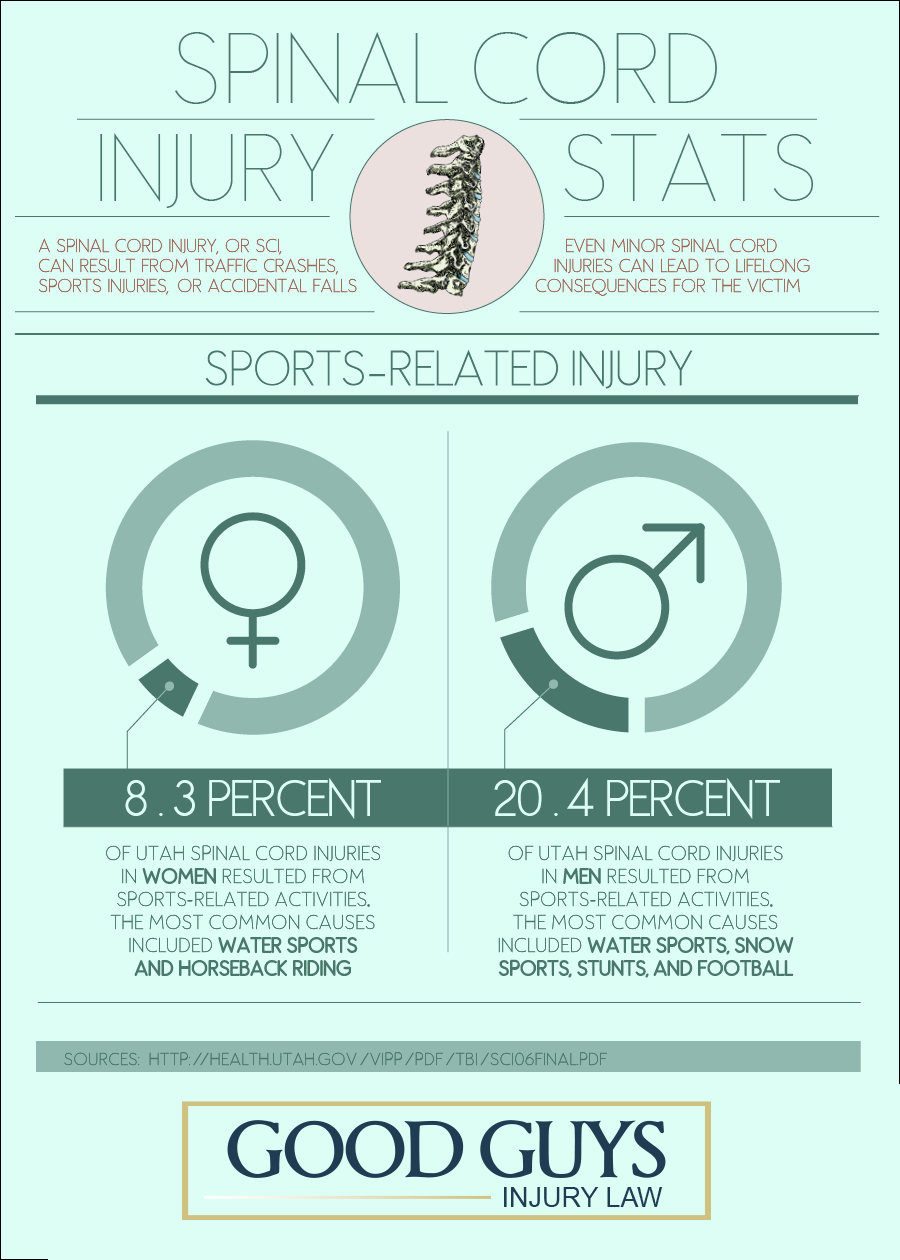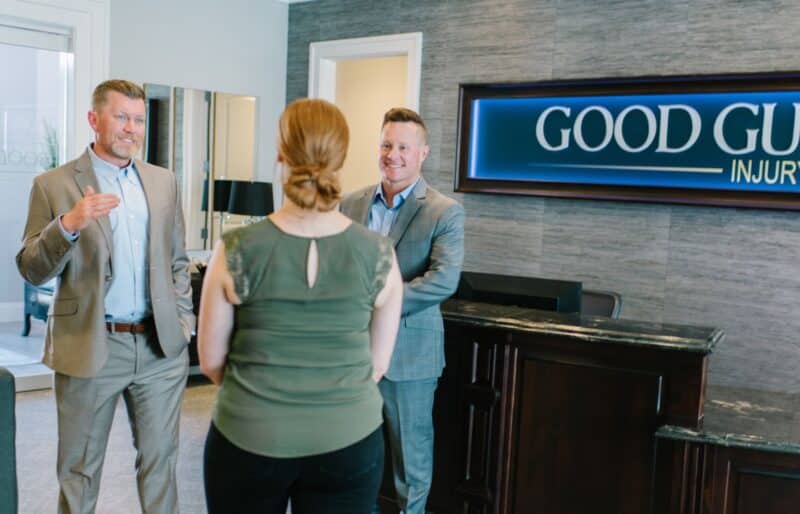 Spinal cord injuries can change lives in a split second. Such injuries are serious, and victims often face physical, emotional, and financial challenges. Good Guys Injury Law understands the impact these injuries have on victims and their families. We handle all types of personal injury cases, including spinal cord injuries.
Spinal cord injuries can change lives in a split second. Such injuries are serious, and victims often face physical, emotional, and financial challenges. Good Guys Injury Law understands the impact these injuries have on victims and their families. We handle all types of personal injury cases, including spinal cord injuries.Even an incomplete spinal cord injury can lead to serious medical problems. Both complete and incomplete spinal cord injuries require immediate medical intervention. Then, give us a call to discuss your spinal cord injury case. We can file a spinal cord injury claim or a spinal cord injury lawsuit on your behalf.
Learn more about incomplete and complete spinal cord injuries below. Then, call our Utah spinal cord injury attorney to schedule a free consultation with our personal injury attorneys.
Table of Contents
Our Utah Spinal Cord Injury Attorneys Are Relentless Advocates for You

A. Legal Consultation and Assessment
The first step is understanding your unique situation. We always start with an initial consult to discuss your spinal cord injury. Our experienced lawyers will assess the strength of your case. Together, we’ll chart the best course of action, which may include a personal injury lawsuit.
B. Investigating the Accident and Gathering Evidence
A successful claim needs solid evidence. We want to get a complete picture of the accident that happened. Our team collects all necessary documents, photos, and witness statements. We leave no stone unturned.
C. Identifying Responsible Parties
Identifying those at fault is crucial. Our lawyers determine who is responsible for your injuries. We’ll hold them accountable, whether it’s a reckless driver in a car accident or a medical malpractice case. We fight for justice on your behalf.
D. Calculating Damages
Understanding the full extent of your losses is vital. We work to calculate all damages, from medical expenses to future care costs. Our team ensures that no aspect of your suffering goes unnoticed. You deserve compensation that reflects your actual needs.
E. Negotiating With Insurance Companies
Insurance companies can be tough negotiators. They often aim to minimize their payouts. Our lawyers know their tactics and stand firm in negotiations. We’re dedicated to securing the best possible outcome for you.
F. Preparing for Trial, if Necessary
While we aim for a fair settlement, we’re ready for trial if needed. Our attorneys prepare each case as if it will go to court. We’re well-versed in courtroom procedures and won’t back down. Your rights and compensation are our top priority.
G. Advocating for Maximum Compensation
Our goal is to get you the maximum compensation possible. We consider all aspects of your injury and its impacts. From physical pain to emotional distress, we advocate for your full recovery. You’re not just a client; you’re family.

If you have been injured in an auto accident, Our car accident attorney is here to help you.

Understanding Spinal Cord Injuries
Spinal cord injuries are complex and vary in severity. A few key points regarding spinal injuries include:
Sacral SCI
The sacral region of the spine is at the very bottom, near the hips. Injuries here often impact the legs, hips, and pelvic organs. While some victims might retain walking ability, others may face mobility challenges. Bowel and bladder functions can also be affected.
Lumbar SCI
The lumbar region is the lower back area. Injuries here can lead to paraplegia, affecting the hips and legs. Many victims lose control of their lower body functions. The severity can range from muscle weakness to complete paralysis.
Thoracic SCI
The thoracic region sits in the mid-back area. Injuries here can be particularly debilitating. They often affect the torso and legs, leading to paraplegia. Such injuries can severely impact a victim’s balance and posture.
Cervical SCI
The cervical region is near the neck at the top of the spine. Injuries in this region can lead to paralysis, affecting both arms and legs. The higher the injury, the more severe the paralysis. Respiratory issues are also common with cervical SCIs.
Causes of Spinal Cord Injuries

Spinal cord injuries can result from various causes. Accidents, falls, and violence are common culprits. Sporting events and diseases can also lead to such injuries. Understanding the cause is crucial for legal claims.
Traumatic Injuries
Traumatic spinal cord injuries often occur suddenly. Car accidents are a leading cause, as high-speed impacts can damage the spine. Falls, especially from significant heights, are another common source. Violent encounters, like gunshot wounds, can also lead to these injuries.
Non-Traumatic Injuries
Non-traumatic spinal cord injuries are typically more gradual. Diseases like cancer, arthritis, and osteoporosis can damage the spine. Infections and inflammation can also lead to SCIs. These injuries might not be sudden, but their impact is as profound.
Types and Severity of Spinal Cord Injuries
Spinal cord injuries vary in type and severity. The location and extent of the injury determine its impact. Some injuries result in partial paralysis, while others lead to complete paralysis. Accurate diagnosis and understanding are essential for treatment and legal action.
Complete vs. Incomplete Injuries
A complete spinal cord injury can lead to impaired function below the injury site. There’s no sensation or movement. An incomplete injury, on the other hand, means some function remains. The extent varies, with some victims retaining significant action and sense.
Dealing with either type of SCI poses challenges. The path to recovery is long for complete injuries, often requiring extensive rehabilitation. Incomplete injuries, while offering hope, still need tailored treatments and therapies. In both scenarios, legal support can be invaluable.
Paraplegia vs. Quadriplegia
Paraplegia results from injuries to the lower spine. It affects the legs and, in some cases, the lower torso. Quadriplegia, stemming from higher injuries, affects both arms and legs. The level of paralysis can range from limited movement to complete loss.
Facing paraplegia or quadriplegia requires immense support. From medical to emotional needs, the journey is challenging. Financial burdens can add to the stress. Our team ensures victims get the compensation they deserve to manage these challenges.
Medical and Rehabilitation Challenges
Spinal cord injuries come with a host of medical challenges. Pain management, respiratory care, and muscle spasticity are common issues. Rehabilitation is crucial, aiming to restore as much function as possible.
Engaging in rehabilitation is a long process. It requires dedication, resources, and the proper support. Physical therapy, occupational therapy, and counseling are common components. Victims can access the help they need for recovery with the appropriate legal support.
Typical Symptoms of Spinal Cord Injuries

Symptoms of spinal injuries can vary greatly. Some experience sharp pain or numbness. Others suffer from muscle weakness or respiratory issues. The effects often depend on the injury’s location and severity.
Early intervention is crucial in spinal cord injuries. Recognizing the symptoms can lead to timely treatment. However, long-term effects can persist, altering life significantly. From mobility challenges to emotional struggles, we understand the symptoms’ breadth and their implications.
Legal Aspects of Spinal Cord Injuries in Utah
Utah laws provide avenues for spinal cord injury victims to seek compensation. The legal landscape can be intricate, but with the proper guidance, justice is attainable. From establishing negligence to dealing with insurance companies, the journey requires expertise.
Liability and Negligence
1. Personal Injury Claims
In Utah, personal injury claims revolve around proving negligence. The at-fault party must have acted carelessly, leading to the injury. Establishing fault is crucial, whether it’s a distracted driver or an unsafe workplace. Our team is adept at gathering evidence and building strong cases.
2. Product Liability
Sometimes, injuries result from defective products. Manufacturers or distributors might be liable if a product fails and leads to an SCI. We meticulously investigate such cases, ensuring responsible parties are held accountable. Victims deserve compensation for the harm caused by faulty products.
Statute of Limitations
In Utah, there’s a time limit for filing personal injury claims. Victims generally have four years from the injury date to file a lawsuit. Missing this deadline can jeopardize the chance for compensation. We guide our clients through the process, ensuring all legal requirements are met timely.
Insurance Claims and Settlements

1. Dealing With Insurance Companies

Insurance companies can be formidable opponents. They often employ tactics to reduce payouts. Our lawyers are familiar with these strategies and counter them effectively. We represent our clients’ best interests, ensuring they get the fair compensation they deserve.
2. Maximizing Compensation
Securing the highest possible compensation is our aim. We consider all damages, from medical bills to emotional distress. Our team negotiates vigorously with insurance companies. We’re committed to getting the best outcome for our clients.
Resources and Support for SCI Victims
A. Rehabilitation Centers in Utah
Rehabilitation is a cornerstone of spinal cord injury recovery. Utah boasts several top-notch centers dedicated to SCI rehabilitation, such as the University of Utah. These centers offer physical, occupational, and speech therapies. Our team can guide victims to the best facilities, ensuring optimal recovery.
B. Support Groups and Counseling
Emotional recovery is as crucial as physical healing. Support groups offer a space for victims to share and heal together. Counseling can also be beneficial, helping individuals cope with the emotional toll. We can connect victims to these vital resources.
C. Government Assistance and Disability Benefits
Many spinal cord injury victims qualify for government benefits. Whether it’s social security disability or Medicaid, such support can be invaluable. Navigating the application process can be complex. We assist our clients, ensuring they access the benefits they’re entitled to.
Compensation Available to Utah Spinal Cord Injury Victims

A. Medical Expenses
Medical bills can quickly accumulate post-injury. Compensation covers doctor visits, surgeries, medications, and more. We ensure that all medical costs, current and future, are factored into the claim.
B. Lost Wages and Future Earnings
Many SCI victims can’t return to work immediately. Some might never regain their previous earning capacity. Compensation accounts for lost wages and potential future earnings. We fight to secure a stable financial future for our clients.
C. Pain and Suffering
The physical and emotional pain from an SCI is immeasurable. While money can’t erase the pain, it can provide some relief. Compensation for pain and suffering recognizes this non-economic loss. We advocate fiercely for the recognition of our client’s grief.
D. Home Modifications and Assistive Devices
Adapting to life post-injury often requires home modifications. Ramps, wider doorways, and unique bathrooms can be necessary. Assistive devices like wheelchairs also come into play. Compensation considers these costs, ensuring a conducive living environment.
E. Emotional Distress
The psychological impact of an SCI is profound. Depression, anxiety, and trauma are common. Compensation for emotional distress recognizes this mental and emotional toll. Our team ensures clients get the support and compensation they need to heal.
F. Punitive Damages (If Applicable)
In cases of extreme negligence, punitive damages might be awarded. These damages are supposed to punish the at-fault party and deter similar behavior. While not common, our team explores every avenue for maximum compensation.


Contact Good Guys Injury Law for Your Free Personal Injury Case Consultation
Contact Our Experienced Utah Spinal Cord Injury Lawyer at Good Guys Injury Law Today for a Free Consultation

Navigating the aftermath of a spinal cord injury can be overwhelming. At Good Guys Injury Law, we’re here to shoulder your legal burdens.
Don’t face this journey alone. With expertise, compassion, and dedication, we stand by our clients every step of the way. Reach out to our Utah spinal cord injury attorney at Good Guys Injury Law today for a free consultation.







